
- •Varieties of grammars.
- •4)Pedagogical (traditional) grammar
- •6)Reference grammar
- •14.Categorial meaning of English adjectives. Their lexical / grammatical subclasses and morphemic structure.
- •20. Categorial meaning of English verbs, their lexical / grammatical subclasses and morphemic structure.
- •1) Actional -Denote the action of the active doer
- •2) Statal -Denote the action of the inactive experiencer
- •21. Morphological categories of English verbs.
- •22. Status of future tense in English.
- •23. Syntagmatic / paradigmatic relations. Types of paradigmatic relations.
- •24. Oppositions in grammar. Binary privative opposition.
- •25. Oppositional reduction, Oppositional substitution.
- •26. History of syntactic studies. Ancient times.
- •27. History of syntactic studies. Middle ages and XIX c.
- •28. Approaches to and achievements in syntactic studies in XX c.
- •29. The phrase. Structural classification of English phrases
- •Independent
- •30. The phrase. Structural classification of English phrases.
- •Verb Phrase
- •Infinitive Phrase
- •31. The definition of the sentence. Distinctive features of English sentences.
- •Classification by purpose
- •(B) classification by structure
- •33. Structural types of simple sentences (after r. Quirk et al).
- •34. Ic method. Types of immediate constituents.
- •Immediate Constituents (ic) method (bloomfield’s term)
- •35. Compound sentences. Types of connections ((a)syndetic)
- •36. Complex sentences. Noun clauses.
- •37. Complex sentences. Adjective clauses.
- •38. Complex sentences. Adverbial clauses.
- •39. Basic notions of pragmatics. Locution, illocution, perlocution. Types of addressees.
- •40. Speech acts classification (John Searle)
- •41. Speech acts classification (Pocheptsov g.G., Shevchenko I.S.)
- •42. Pragmatic transposition.
- •43. Text and discourse (approaches to distinguishing)
- •44.Seven principles of textuality (r de Beaugrande)
- •45. Grammatical cohesion of the text (m.A.K. Halliday, r.Hasan). Types of cohesive devices.
- •2) Ellipsis
- •3) Substitution
- •46. Lexical cohesion of the text (m.A.K. Halliday, r.Hasan).
- •47. Coherence :: cohesion of the text. Types of relations of coherence.
- •48. Spontaneous and induced discourse.
- •49. Discourse analysis as a social research method.
- •50. Levels of sociological discourse analysis.
- •51. Textual discourse analysis. Discourse as object.
- •52. Content as a level of discourse analysis.
- •53. Contextual discourse analysis.
- •54. Interpretation as discourse analysis.
- •55. Semiotic (structural and formal) as a level of textual discourse analysis.
- •56. Frame discourse analysis.
- •57. Conversation discourse analysis.
- •58. Sociological interpretation of discourse.
- •59. Discourse as social information.
Types of grammatical description of the English language (= varieties of Grammar).
The notion of grammar. Descriptive vs prescriptive grammar.
TRADITIONALLY in linguistics, grammar is the set of structural rules that governs the composition of clauses, phrases, and words in any given natural language.
abstract character: it abstracts itself from particular & concrete and builds its rules & laws, taking into consideration only common features of groups and words.
stability (laws & categories of Grammar exist through ages without considerable changes).
Descriptive is an approach that describes the grammatical constructions that are used in a language, without making any evaluative judgments about their standing in society.
These grammars are commonplace in linguistics, where it is standard practice to investigate a 'corpus' of spoken or written material, and to describe in detail the patterns it contains.
Cognitive
Comparative
Generative
Mental
Performance
Reference
Theoretical
Transformational
Universal
Prescriptive try to enforce rules about what they believe to be the correct uses of language.
is a manual that focuses on constructions where usage is divided, and lays down rules governing the socially correct use of language.
Pedagogical (traditional),
Practical
Grammatical analysis and instruction designed for second-language students.
Pedagogical grammar is commonly used to denote.
(1) pedagogical process- the explicit treatment of elements of the target language systems as (part of) language teaching methodology;
(2) pedagogical content-reference sources of one kind or another that present information about the target language system
Varieties of grammars.
1)Comparative grammar was important in Europe (19th c.). Also called comparative philology, was originally stimulated by the discovery by Sir William Jones (1786) that Sanskrit was related to Latin, Greek, and German. Is the study of the relationships or correspondences between two or more languages and the techniques used to discover whether the languages have a common ancestor. provides an explanatory basis for how a human being can acquire a first language.
The theory of grammar is a theory of human language and hence establishes the relationship among all languages.
It assumed a view of linguistic change as large, systematic and lawful and on the basis of this assumption attempted to explain the relationship between languages in terms of a common ancestor often a historical one for which there was no actual evidence in the historical record.
2)Generative grammar arguably originates in the work of Noam Chomsky, beginning in the late 1950s.
refers to a particular approach to the study of syntax. attempts to give a set of rules that will correctly predict which combinations of words will form grammatical sentences. GG rules function as an algorithm to predict grammaticality as a discrete (yes-or-no) result.
3)Mental grammar The generative grammar stored in the brain that allows a speaker to produce language that other speakers can understand, the innate basis for learning, speaking and understanding any (verbal) language."All humans are born with the capacity for constructing a Mental Grammar, given linguistic experience; this capacity for language is called the Language Faculty (Chomsky)
4)Pedagogical (traditional) grammar
5)Performance grammar aims not only at describing and explaining intuitive judgments and other data concerning the well-formedness of sentences of a language as they are actually used by speakers in dialogues. PG centers attention on language production; the problem of production is dealt with before problems of reception and comprehension
6)Reference grammar
7)Theoretical grammar An approach that goes beyond the study of individual languages, to determine what constructs are needed in order to do any kind of grammatical analysis, and how these can be applied consistently in the investigation of linguistic universals Unlike school grammar, theoretical grammar does not always produce a ready-made decision. In language there are a number of phenomena interpreted differently by different linguists
8)Transformational grammar Models of Tras. G
Standard Theory (1957–1965) Extended Standard Theory (1965–1973) Revised Extended Standard Theory (1973–1976) Relational grammar (ca. 1975–1990) Government and binding/Principles and parameters theory (1981–1990) Minimalist Program (1990–present)
9)Universal grammar (Noam Chomsky): ability to learn grammar is hard-wired into the brain. linguistic ability manifests itself without being taught, and that there are properties that all natural human languages share. It is a matter of observation and experimentation to determine precisely what abilities are innate and what properties are shared by all languages.
Morphology and syntax as parts of grammar.
The grammatical structure of language comprises two major parts – morphology and syntax. The two areas are obviously interdependent and together they constitute the study of grammar.
Morphologydeals with paradigmatic and syntagmatic properties of morphological units – morphemes and words. It is concerned with the internal structure of words and their relationship to other words and word forms within the paradigm. It studies morphological categories and their realization.
Syntax, on the other hand, deals with the way words are combined. It is concerned with the external functions of words and their relationship to other words within the linearly ordered units – word-groups, sentences and texts. Syntax studies the way in which the units and their meanings are combined. It also deals with peculiarities of syntactic units, their behavior in different contexts.
Syntacticunits may be analyzed from different points of view, and accordingly, different syntactic theories exist.
Theoretical grammar of English as a branch linguistics
An approach that goes beyond the study of individual languages, to determine what constructs are needed in order to do any kind of grammatical analysis, and how these can be applied consistently in the investigation of linguistic universals.
Unlike school grammar, theoretical grammar does not always produce a ready-made decision. In language there are a number of phenomena interpreted differently by different linguists.
TG studies the forms of the words & their relations in sentences in more abstract way, giving the profound description of existing grammatical laws & tendencies; looks inside into the structure of parts of language & expose the mechanisms of their functioning. The aim of TG is to present a scientific description of a certain language in terms of its grammatical system.
Typological classification of languages. Synthetic and analytic grammatical means.
Attempts to classify languages by their types rather than by their relationships were made from the beginning of historical linguistics. In 1818 August Von Schlegel proposed a typological classification which was widely followed and elaborated through the 19th century and still has a great popularity. Schlegel's system was based on the number of meaningful elements (morphemes) which could be present in a word and the modification these might undergo. According to this classification, languages can be divided into three types- isolating or analytic, inflectional or synthetic, and agglutinative
1.ISOLATING (analysis): Isolating languages exhibit no formal paradigms. It has only one element of basic meaning per word and in such cases they are monomorphemic. For example, when, as, since, from, etc. and their grammatical status and class-membership is determined by their syntactic relations with the rest of the sentence in which they occur. In English invariable words such as prepositions, conjunctions and many adverbs are isolating in types. Chinese, several other Southeast Asian languages-Vietnamese are examples of such types.Words in such languages are assigned to word-classes on the basis of different syntactic functions.
2. INFLECTIONAL: If there are several meaningful elements, but are in some way fused together or are modified in different contexts, the language will be inflectional. In it words having several grammatical forms in which it is difficult to assign each category to a specific and serially identifiable morphemic section. Classical languages such as Latin, Ancient Greek, Sanskrit are the most obvious examples of such type. English nouns such as men, geese, mice, women are inflectional. Inflectional languages were held to represent the highest stage of evolution and the most perfect form of human communication.
3. AGGLUTINATIVE: If there is more than one element of basic meaning, but these were kept apart from one another and undergo no modification, the language is agglutinative. Morphologically complex words in which individual grammatical categories may be easily assigned to morphemes stung together serially in the structure of the word-form exemplify the process of agglutination. Turkish, Sudanese and Japanese are examples of such type with the Turkish as the perfect one. Languages of these types are alike of necessity in respect of word structure. Grammars of these languages are very different in other respects.
Analytic languages.
analytic / isolating / root languages (English, Chinese, Vietnamese) - all words are invariable
- syntactic relationships are shown by word order
- in order to express person, case, and other categories, the language needs single words
- prepositional phrases and modal verbs are used → to the boy, did he arrive?
are defined as being of ‘external’ grammar of the word.
Analytic features are traced in morphological lack of changeability of the word and existence of periphrastic constructions. The words remaining morphologically unchanged convey the grammatical meaning by combining with auxiliary or notional words, word order is strict.
Many words – analytic
Synthetical languages.
- synthetic / inflectional / inflecting languages (Czech, Finnish, Latin, Arabic)
- the words typically contain more than one morpheme
- there is no one-to-one correspondence between the morphemes and the linear structure of the word
- words are formed by suffixes, declination, conjugation etc.
- forms of person, case, and other categories are compounded in one word
- are defined as the languages of the ‘internal’ grammar of the word.
- are inflectional: most grammatical meanings and most grammatical relations of the words are primarily expressed by inflectional devices.
Morphological forms can be regarded as synthetic where the base of the word is inseparably connected with its formants, presenting a grammatical category.
More than one morpheme in a word - synthetic
Language system and language structure.
Language is regarded as a system of elements (or: signs, units) such as sounds, words, etc. These elements have no value without each other, they depend on each other, they exist only in a system, and they are nothing without a system. System implies the characterization of a complex object as made up of separate parts (e.g. the system of sounds). Language is a structural system. Structuremeans hierarchical layering of parts in `constituting the whole. In the structure of language there are four main structural levels: phonological, morphological, syntactical and supersyntatical. The levels are represented by the corresponding level units:
The phonological level is the lowest level. The phonological level unit is the`phoneme. It is a distinctive unit (bag – back).
The morphological level has two level units:
the `morpheme – the lowest meaningful unit (teach – teacher);
the word - the main naming (`nominative) unit of language.
The syntactical level has two level units as well:
the word-group – the dependent syntactic unit;
the sentence – the main communicative unit.
The supersyntactical level has the text as its level unit.
To sum it up, each level has its own system. Therefore, language is regarded as a system of systems. The level units are built up in the same way and that is why the units of a lower level serve the building material for the units of a higher level. This similarity and likeness of organization of linguistic units is called isomorphism. This is how language works – a small number of elements at one level can enter into thousands of different combinations to form units at the other level.
Parts of speech in English: criteria.
The parts of speech are classes of words, all the members of these classes having certain characteristics in common which distinguish them fr om the members of other classes. The problem of word classification into parts of speech still remains one of the most controversial problems in modern linguistics. There are four approaches to the problem:
Classical (logical-inflectional)
Functional
Distributional
Complex
Classical approach
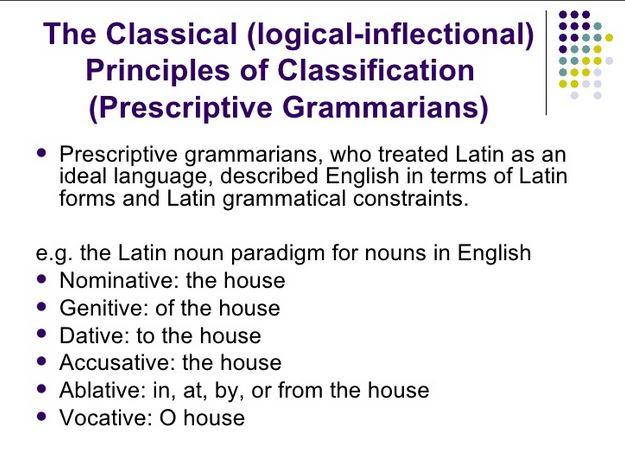
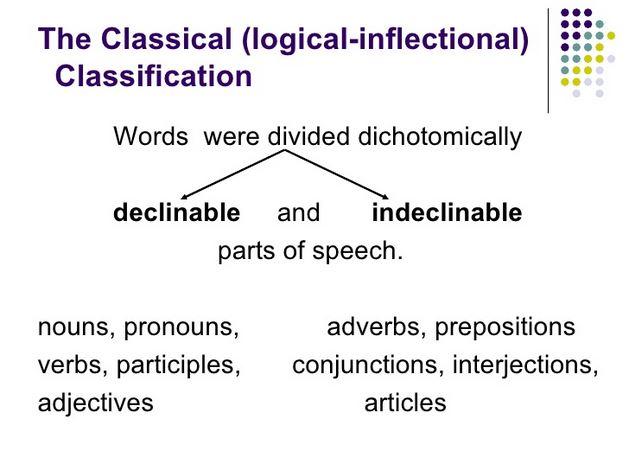
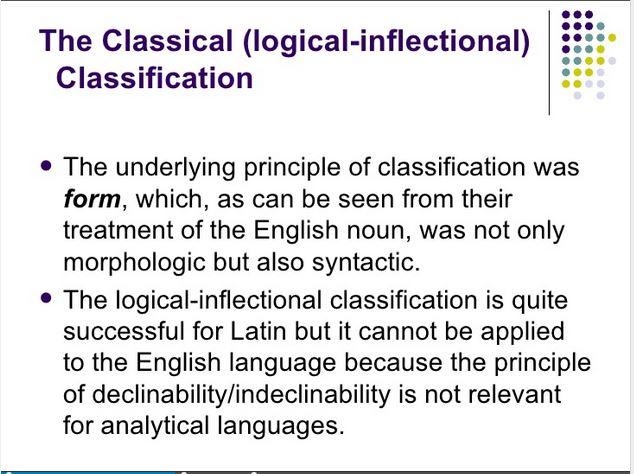
Functional approach
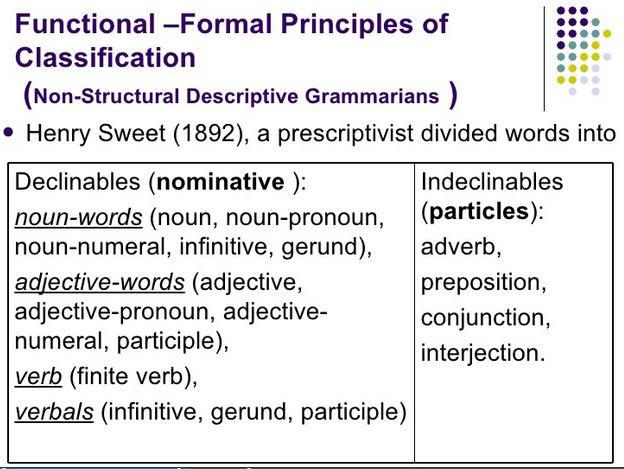
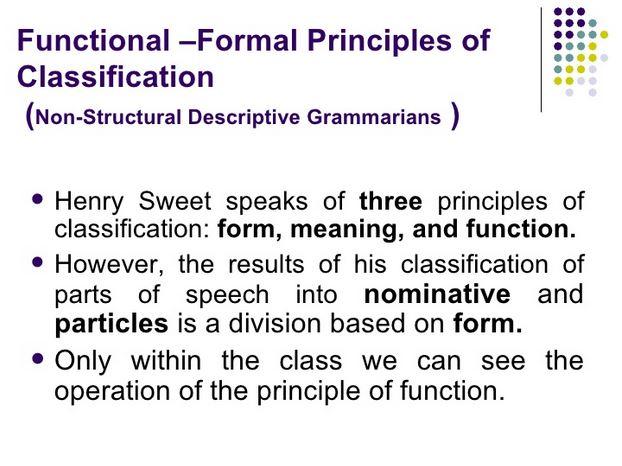
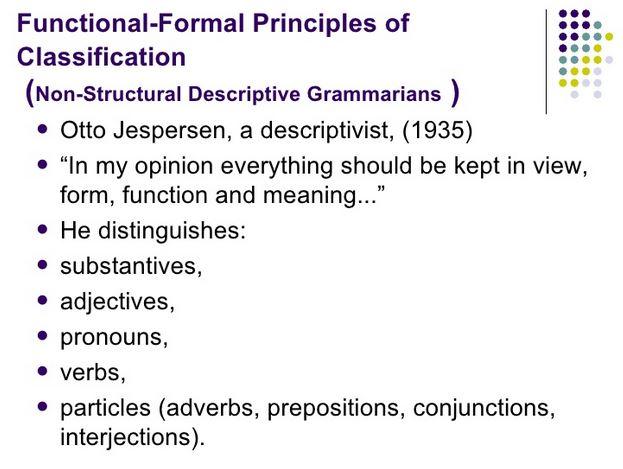
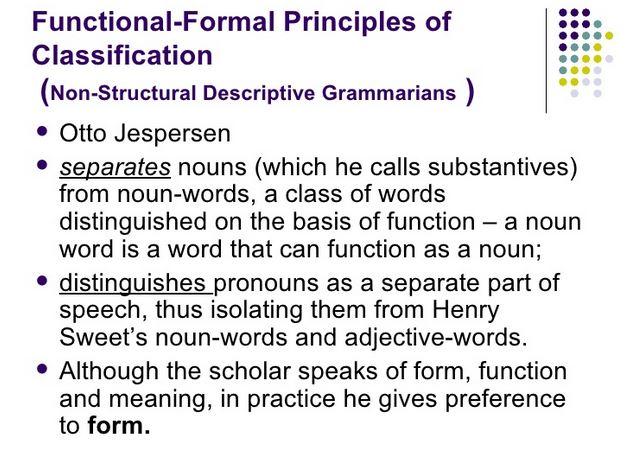
Distributional approach
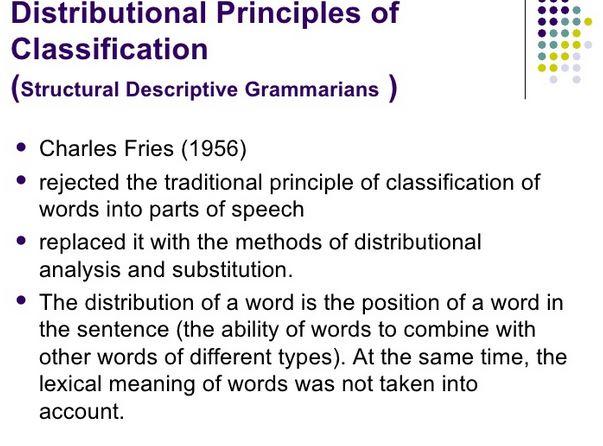
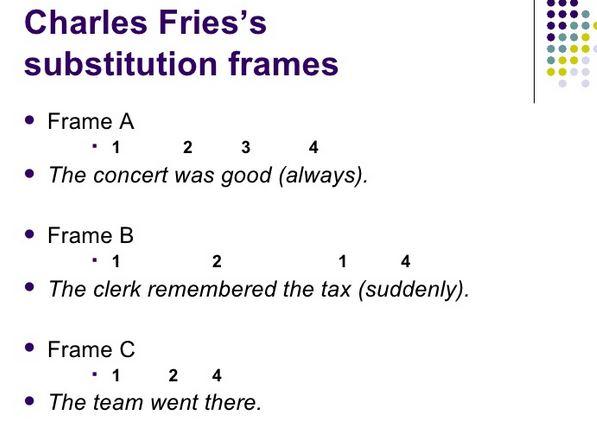
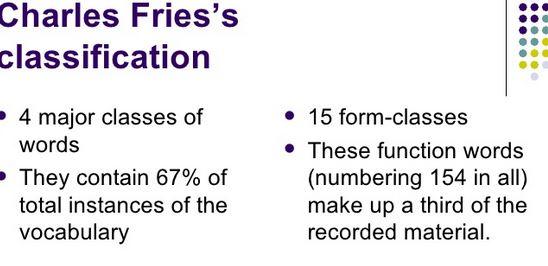
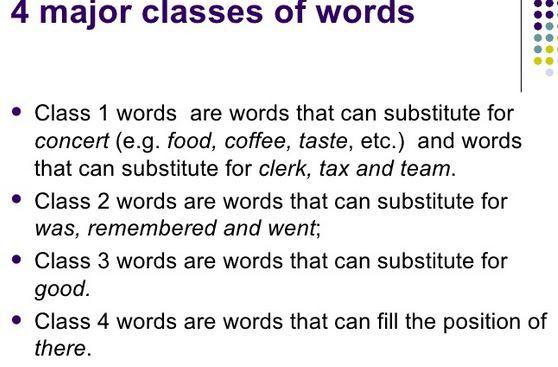
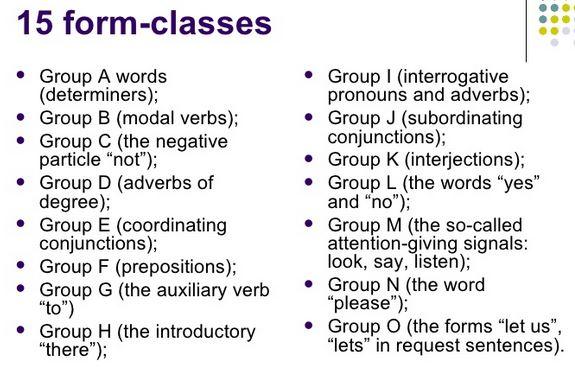
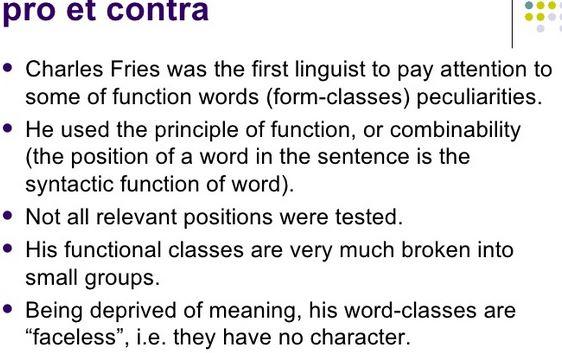
Complex approach
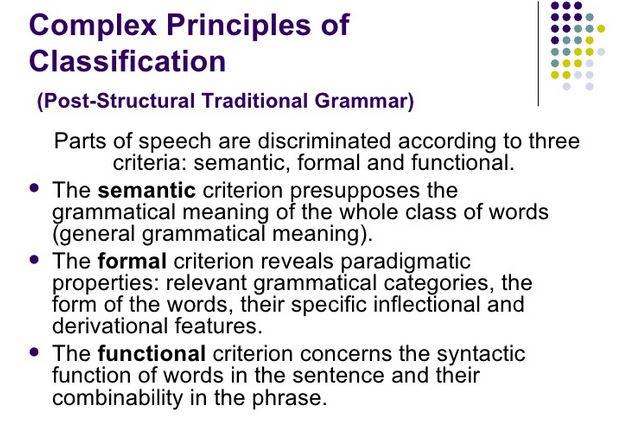
The field nature of parts of speech
The notional :: functional parts of speech
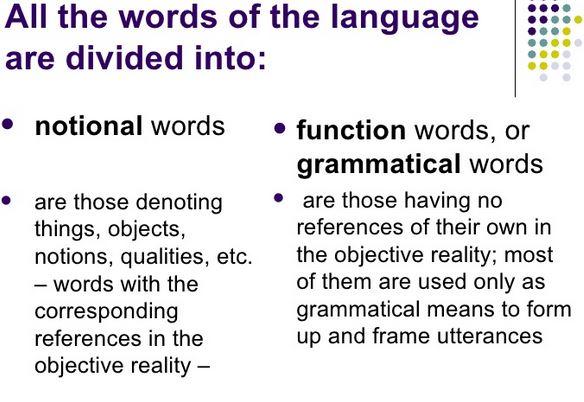
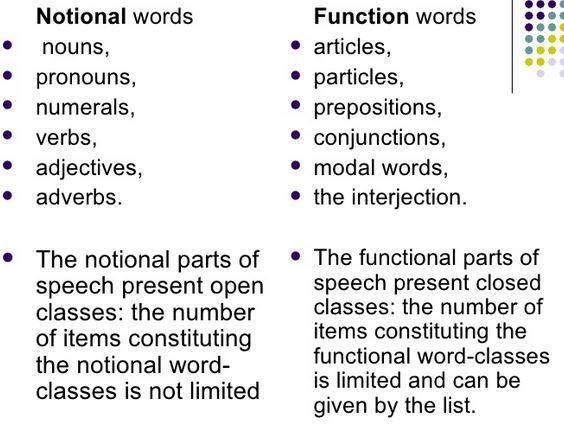
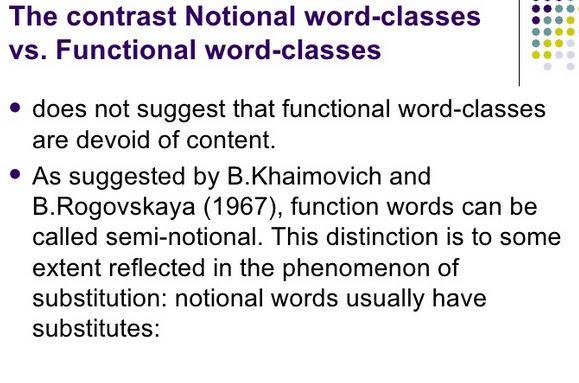
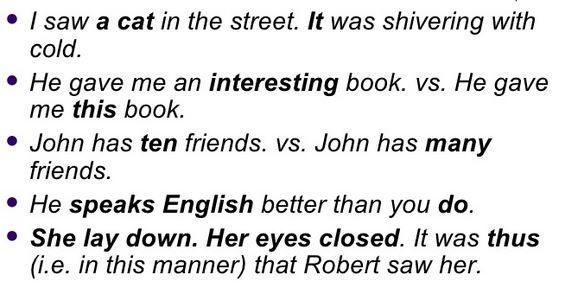
Notional parts of speech perform certain functions in the sentence whereas functional express relations between the words. Functional parts of speech never change their form.
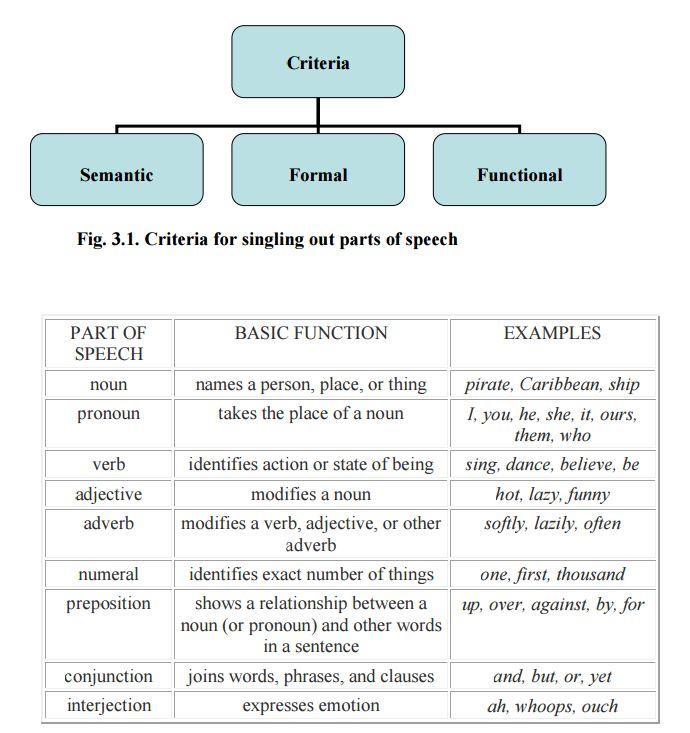
Limitations to the traditional classification of the parts of speech in English
Traditionally, all parts of speech are subdivided on the upper level of classification into notional words andfunctional words. Notional words, which traditionally include nouns, verbs, adjectives, adverbs, pronouns and numerals, have complete nominative meanings, are in most cases changeable and fulfill self-dependent syntactic functions in the sentence. Functional words, which include conjunctions, prepositions, articles, interjections, particles, and modal words, have incomplete nominative value, are unchangeable and fulfill mediatory, constructional syntactic functions.
There are certain limitations and controversial points in the traditional classification of parts of speech, which make some linguists doubt its scientific credibility. First of all, the three criteria(semantic,formal,functional) turn out to be relevant only for the subdivision of notional words.
As for functional words, they are rather characterized by the absence of all three criteria in any generalized form.
Second, the status of pronouns and the numerals, which in the traditional classification are listed as notional, is also questionable, since they do not have any syntactic functions of their own, but rather different groups inside these two classes resemble in their formal and functional properties different notional parts of speech: e.g., cardinal numerals function as substantives, while ordinal numerals function as adjectives; the same can be said about personal pronouns and possessive pronouns.
Third, it is very difficult to draw rigorous borderlines between different classes of words, because there are always phenomena that are indistinguishable in their status. E.g., non-finite forms of verbs, such as the infinitive, the gerund, participles I and II are actually verbal forms, but lack some of the characteristics of the verb: they have no person or number forms, no tense or mood forms, and what is even more important, they never perform the characteristic verbal function, that of a predicate. There are even words that defy any classification at all; for example, many linguists doubt whether the words of agreement and disagreement, yes and no, can occupy any position in the classification of parts of speech.
These, and a number of other problems, made linguists search for alternative ways to classify lexical units. Some of them suggested that the contradictions should be settled if parts of speech were classified a unified basis of subdivision; in other words, if a homogeneous, or monodifferential classification of parts of speech were undertaken. It must be noted that the idea was not entirely new. The first classification of parts of speech was homogeneous: in ancient Greek grammar the words were subdivided mainly on the basis of their formal properties into changeable and unchangeable; nouns, adjectives and numerals were treated jointly as a big class of “names” because they shared the same morphological forms. This classical linguistic tradition was followed by the first English grammars: Henry Sweet divided all the words in English into “declinables” and “indeclinables”.
Alternative approaches to the traditional classification of the parts of speech
H. Sweet is a prominent English grammarian. His “New English Grammar, Logical and Historical” (1891) is an attempt of a descriptive grammar intended to break away from the canons of classical Latin grammar and to give scientific explanation to grammatical phenomena. His classification of parts of speech makes distinction between: 1) declinables: - noun-words: nouns, noun-pronouns, noun-numerals, infinitives, gerunds; - adjective-words: adjectives, adjective-pronouns, adjective-numerals, participles; - verbs: finite verbs, verbals (infinitive, participle, gerund); 2) indeclinables (particles): adverbs, prepositions, conjunctions, interjections. H. Sweet could not fully disentangle himself from the rules of classical grammar (Greek, Latin).
In “The Philosophy of Grammar” (1924) he presents his Theory of Three Ranks describing the hierarchy of syntactic relations underlying linear representation of elements in language structures. The theory is based on the concept of determination. The “rank” of a word (primary, secondary, or tertiary) depends upon its relation (that of defined or defining) to other words in a sentence.
Nothing cardinally different from the traditional approach in the part-of-speech classification was produced by various English grammars within the period between the works of O. Jespersen and the appearance of Ch. Fries’s book “The Structure of English” (1952). Ch. Fries belongs to the American school of descriptive linguistics for which the starting point and basis of any linguistic analysis is the distribution of elements. In contrast to other representatives of that school, who excluded meaning from linguistic description, Fries recognized its importance. He introduced the notion of structural meaning as different from the lexical meaning of words. In his opinion, the grammar of the language consists of the devices that signal structural meanings. So a part of speech, according to Ch. Fries, is a functional pattern. All the words which can occupy the same ‘set of positions’ in the pattern of English utterances must belong to same part of speech. Fries recorded 50 hours of conversation by 300 different speakers and analyzed 250.000 word entries. As a result of this analysis he singles out four wordclasses (1, 2, 3, and 4) and 15 subclasses of function words (designated by the letters of Latin alphabet), in which the properties of different word-classes, which are singled out by traditional grammar, are dissolved in the distributional patterns. Ch. Fries’s book presents a major linguistic interest as an experiment rather than for its achievements.
Categorial meaning of English nouns. Their lexical / grammatical subclasses and morphemic structure.
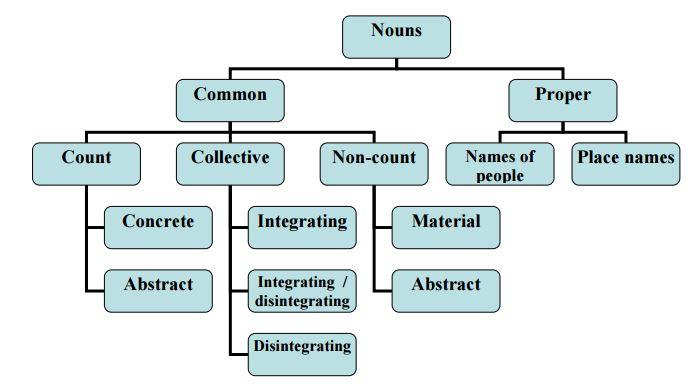
In English, the noun is characterized by the categorial meaning of substantivity or thingnesswhich is perceived in any noun irrespective of the form and lexical meaning: e.g.worker, teacher, doctor as doer of action; book, chair, house as a separate thing; rain, water, snow as natural phenomenon; love, beauty, generosity as an abstract notion, and so on. The main paradigmatic classes are found possible to distinguish:commonnouns andpropernouns.
Common nouns:
Concrete – denoting single physical objects (animate or inanimate) having a certain shape and measurements (e.g. table, pupil, lamp, dog);
Collective – denoting a group of objects (animate or inanimate) or paired objects (e.g. family, crew, delegation, government staff, jury, jeans, earrings, trousers);
Mass – denoting a physical substance having no particular shape or measurements (e.g. bread, sugar, copper, wine, snow, air, milk);
Abstract – denoting abstracted states, qualities, feelings (e.g. kindness, adoration, length, knowledge, delight, confidence, experience).
As far as proper nounsare concerned, they split into some common subclasses as well indicating names of people, nationalities(the British, Ukrainians, Russian), family names (Byron, Adams, Newton), geographical names(the Black Sea, Chicago, Moscow, the Pacific ocean), names of companies, hotels, newspapers, journals (Ford, the Daily News, the Hilton).
There is some peculiarity in the realization of the meaning of number and quantity in some groups of nouns in English. Firstly, a noun with the same form can have different kinds of meanings and, therefore, can function differently: concrete/abstract: a beauty – beauty, красавица – красота; an authority – authority, влиятельный человек – влияние; a witness – witness, свидетель – свидетельство; concrete thing/material: a lemon – lemon, лимон – сок; a chicken – chicken, цыпленок – мясо; an iron – iron, утюг – железо; a wood – wood, лес – древесина. Secondly, collective nouns may be used both in singular and in plural (when the constituent members of these collective nouns are meant): e.g. The crew are operating perfectly / The crew is excellent. The family go on holiday every summer / His family is not big.
Taking into account the substantive featuring of a noun, it is possible to identify its functional role in forming a sentence pattern: subject(The company is based in the capital city), object(We visited museums), predicative (He is anoffice worker), attribute(I like sea coast villages), adverbial modifier (There were a lot of people at the airport).
As a part of speech the noun is described in its peculiarity as a word with a specific morphemic structurecreated with noun-forming derivational means, among themaffixationandcompounding:
prefixes: co-, ex-, over-, post-, under-, dis-, im-, un-:
e.g. co-operation, ex-president, overeating, underestimation, postgraduate, disagreement, impossibility, unimportance;
suffixes: -ee, -er, -age, -ance, -tion, -ence, -ment, -cy, -ity, -hood, -ness, -ship:
e.g. employee, worker, breakage, annoyance, organization, preference, amazement, fluency, popularity, childhood, kindness, friendship;
compounding:
adjective + noun: e.g. greenhouse, heavyweight, blackboard, self-confidence, rush hours, safety belt;
noun + noun: e.g. cupboard, rainforest, countryside, chairman, teapot, earthquake, saucepan;
gerund + noun: e.g. frying pan, drinking water, shaving cream, working hours, chewing gum, writing paper, walking stick.
Morphological categories of English nouns; the problematic status of gender
Morphological features of the noun. In accordance with the morphological structure of the stems all nouns can be classified into: simple, derived (stem +affix, affix + stem – thingness); compound (stem+ stem – armchair ) and composite (the Hague). The noun has morphological categories of number and case. Some scholars admit the existence of the category of gender.
Gender.
In Indo-European languages the category of gender is presented with flexions. It is not based on sex distinction, but it is purely grammatical.
According to some language analysts (B.Ilyish, F.Palmer, and E.Morokhovskaya), nouns have no category of gender in Modern English. Prof. Ilyish states that not a single word in Modern English shows any peculiarities in its morphology due to its denoting male or female being. Thus, the words husband and wife do not show any difference in their forms due to peculiarities of their lexical meaning. The difference between such nouns as actor and actress is a purely lexical one.
Gender distinctions in English are marked for a limited number of nouns. In present-day English there are some morphemes which present differences between masculine and feminine (waiter – waitress, widow – widower). This distinction is not grammatically universal. Only a limited number of words are marked as belonging to masculine, feminine or neuter. The morpheme on which the distinction between masculine and feminine is based in English is a word- building morpheme, not form-building.
Still, other scholars (M.Blokh, John Lyons) admit the existence of the category of gender. Prof. Blokh states that the existence of the category of gender in Modern English can be proved by the correlation of nouns with personal pronouns of the third person (he, she, it). Accordingly, there are three genders in English: the neuter (non-person) gender, the masculine gender, the feminine gender.
Syntactic functions of the English noun.

Syntactic features of the noun. The noun can be used in the sentence in all syntactic functions but predicate. Speaking about noun combinability, we can say that it can go into right-hand and left-hand connections with practically all parts of speech. That is why practically all parts of speech but the verb can act as noun determiners. However, the most common noun determiners are considered to be articles, pronouns, numerals, adjectives and nouns themselves in the common and genitive case.
The category of case of English nouns. Meaning of case (R.Quirk et al). The six cases of nouns (Charles Fillmore).
is the morphological category of the noun manifested in the forms of noun declension and showing the relations of the nounal referent to other objects and phenomena. is a very speculative issue, so different scholars stick to a different number of cases. The following four approaches, advanced at various times by different scholars
Theory of positional cases J. C. Nesfield, M. Deutchbein, M. Bryant et al follow the patterns of classical Latin grammar, distinguishing
NOMINATIVE (case corresponds with the subject),
GENITIVE, DATIVE (indirect object),
ACCUSATIVE (direct object),
VOCATIVE (with the address).
“The theory of positional cases” presents an obvious confusion of the formal, morphological characteristics of the noun and its functional, syntactic features.
Theory of prepositional cases (G. Curme)
Latin-oriented, dased on old school grammar traditions: treats the combinations of nouns with prepositions as specific analytical case forms,
e.g.: the DATIVE case is expressed by nouns with the prepositions ‘to’ and ‘for’,
the GENITIVE case by nouns with the preposition ‘of’, the instrumental case by nouns with the preposition ‘with’, e.g.: for the girl, of the girl, with a key.
Theory of limited case H. Sweet, O. Jespersen, developed by Russian linguists A. Smirnitsky, L. Barkhudarov
the most widely accepted theory of case in English
The category of case is realized in full in animate nouns and restrictedly in inanimate nouns in English, hence the name – “the theory of limited case”
the category of case is expressed by the opposition of two forms: the first form, “the genitive case”, is the strong member of the opposition, marked by the postpositional element ‘–s’ after an apostrophe in the singular and just an apostrophe in the plural; the second, unfeatured form is the weak member of the opposition and is usually referred to as “the common case” (“non-genitive”).
“the theory of the possessive postposition” G. N. Vorontsova, A. M. Mukhin
The main arguments to support this point: first, the postpositional element ‘s is not only used with words, but also with the units larger than the word, with word-combinations and even sentences, e.g.: his daughter Mary’s arrival, the man I saw yesterday’s face
In present-day linguistics case is used in two senses: 1) semantic, or logic, and 2) syntactic. The semantic case concept was developed by C. J. Fillmore in the late 1960s. Ch. Fillmore ntroduced syntactic-semantic classification of cases. They show relations in the so-called deep structure of the sentence. According to him, verbs may stand to different relations to nouns. There are 6 cases:
1. Agentive Case (A) John opened the door;
2. Instrumental case (I) The key opened the door; John used the key to open the door;
3. Dative Case (D) John believed that he would win (the case of the animate being affected by the state of action identified by the verb);
4. Factitive Case (F) The key was damaged (the result of the action or state identified by the verb);
5. Locative Case (L) Chicago is windy;
6. Objective case (O) John stole the book.
Case expresses the relation of a word to another word in the word-group or sentence (my sister’s coat). The category of case correlates with the objective category of possession. The case category in English is realized through the opposition: The Common Case :: The Possessive Case (sister :: sister’s). However, in modern linguistics the term “genitive case” is used instead of the “possessive case” because the meanings rendered by the “`s” sign are not only those of possession. The scope of meanings rendered by the Genitive Case is the following:
1. Possessive Genitive : Mary’s father – Mary has a father,
2. Subjective Genitive: The doctor’s arrival – The doctor has arrived,
3. Objective Genitive : The man’s release – The man was released,
4. Genitive of origin: the boy’s story – the boy told the story,
5. Descriptive Genitive: children’s books – books for children
6. Genitive of measure and partitive genitive: a mile’s distance, a day’s trip
7. Appositive genitive: the city of London.
Categorial status of English articles.
The question is whether the article is a separate part of speech (i.e. a word) or a word-morpheme. If we treat the article as a word, we shall have to admit that English has only two articles - the and a/an. But if we treat the article as a word- morpheme, we shall have three articles - the, a/an,
B.Ilyish (1971:57) thinks that the choice between the two alternatives remains a matter of opinion. M.Blokh (op. cit., 85) regards the article as a special type of grammatical auxiliary. Linguists are only agreed on the function of the article: the article is a determiner, or a restricter.
The articles, according to some linguists, do not form a grammatical category. The articles, they argue, do not belong to the same lexeme, and they do not have meaning common to them: a/an has the meaning of oneness, not found in the, which has a demonstrative meaning.
If we treat the article as a morpheme, then we shall have to set up a grammatical category in the noun, the category of determination. This category will have to have all the characteristic features of a grammatical category: common meaning + distinctive meaning. So what is common to a room and the room? Both nouns are restricted in meaning, i.e. they refer to an individual member of the class ‘room’. What makes them distinct is that a room has the feature [-Definite], while the room has the feature [+Definite]. In this opposition the definite article is the strong member and the indefinite article is the weak member.
